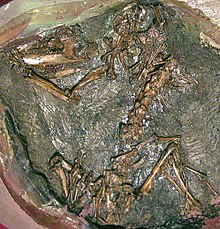Henkelotherium is an extinct genus of dryolestidan mammal from the Late Jurassic (Kimmeridgian) Camadas de Guimarota, in Portugal.[1] Unlike many other Jurassic mammals, it is known from a largely complete skeleton, and is thought to have had an arboreal lifestyle.
| Henkelotherium
Temporal range: Late Jurassic, Kimmeridgian
| |
|---|---|

| |
| Skeleton | |
| Scientific classification | |
| Domain: | Eukaryota |
| Kingdom: | Animalia |
| Phylum: | Chordata |
| Class: | Mammalia |
| Order: | †Dryolestida |
| Genus: | †Henkelotherium Krebs, 1991 |
| Species: |
†H. guimarotae
|
| Binomial name | |
| †Henkelotherium guimarotae Krebs, 1991 | |
The skull of Henkelotherium is 4 cm (1.6 in) long, and presacral body length is 11 cm (4.3 in). This suggest a weight of about 20 g (0.71 oz).[2]
Primitive characters of Henkelotherium (e.g. asymmetric condyles of the femur) indicate that this species had a mode of locomotion similar to tree shrews and opossums. The small size of Henkelotherium and elongated tail made it suited to an arboreal lifestyle and capable of climbing trees, a notion supported by the paleoecological reconstruction of the Guimarota ecosystem indicating a densely vegetated environment.[3][4]
In cladistic analyses, Henkelotherium has been considered closely related to Dryolestidae, either as a part of that group, or as closely related but placed outside that family as a non-dryolestid dryolestidan.[5]
http://www.diss.fu-berlin.de/diss/receive/FUDISS_thesis_000000001206
This article about a Jurassic mammal is a stub. You can help Wikipedia by expanding it. |